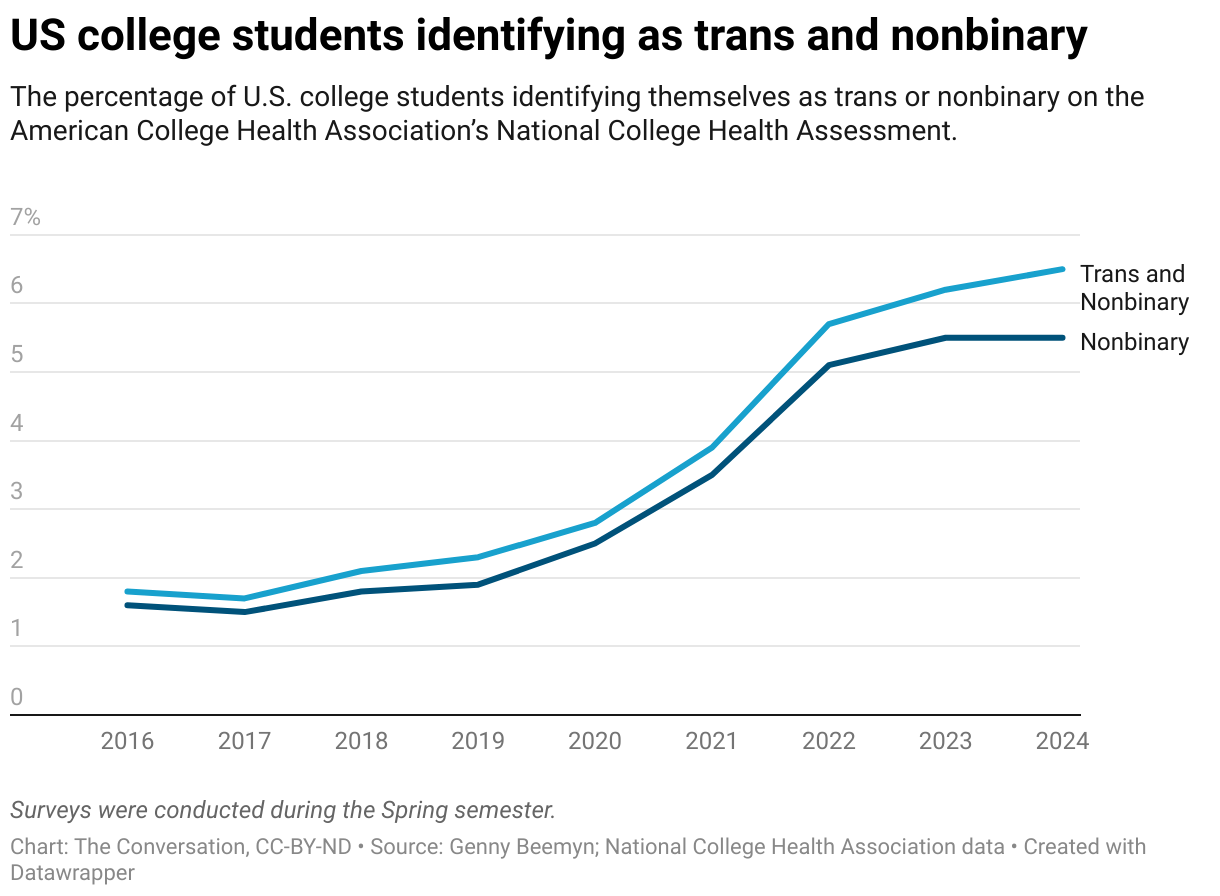Nonbinary students may be wary of being ‘out’ on their college applications. Vladimir Vladimirov via Getty Images
by Genny Beemyn, UMass Amherst
The national backlash against trans and nonbinary young people may have led fewer nonbinary students to disclose their gender identity in their applications to college for this fall.
That is according to my analysis of how students who applied to college through the Common App identified their gender. The Common App is a good barometer because more than 1 million students use it annually to apply to more than 1,000 U.S. schools.
For the most recent admissions cycle, 1.88% of students, or 23,620 individuals, chose a nonbinary gender term to describe themselves, down from 2.2%, or 25,959 individuals, in the last cycle.
That may not seem like a large drop, but it is a huge change from the past few years, when the number of students indicating that they were nonbinary had skyrocketed. For example, on one of the largest surveys of college students, the American College Health Association’s National College Health Assessment, the percent of students identifying as nonbinary more than doubled from 2020 to 2022, going from 2.5% to 5.1%. Then, in spring 2023, the rate of increase slowed significantly to 5.5%, and there was no increase in the percent of nonbinary students in spring 2024.
Different data, same trend
The much lower percentage of nonbinary students on the Common App than the National College Health Assessment may seem noteworthy in itself, but this is because of differences in how the data is collected.
The Common App shows a much smaller nonbinary population because its users are typically 17- and 18-year-olds. At this age, students may not yet recognize or understand their gender identity. They also may be filling out the form with family members to whom they are not out so would not feel that they could disclose. And even if they are out to their families, applicants may hold back out of concern that indicating their gender identity could result in discrimination and harm their prospects of admission.
In contrast, the National College Health Assessment is filled out online voluntarily by college students at all class levels. Because the participants are older and the survey is anonymous, the percentage of students willing to indicate that they are nonbinary is much higher.
Still, the trend is the same. Students seem less willing to identify as nonbinary on forms and surveys today.
Facing public hostility
The lack of growth in nonbinary students disclosing could be a one-year aberration. After all, the percent of students who identified as trans women and men on both the Common App and the National College Health Assessment rose this past year.
But unlike most trans female and male students, nonbinary students are typically not changing their bodies through hormones and surgeries. Thus, they are often not readily seen by others as part of the trans community and have a choice about whether to disclose their gender identity. It seems that a growing number are choosing not to be out due to the anti-trans environment in many parts of society.
The public discourse today around gender diversity is often harsh. Democratic presidential nominee Kamala Harris, for instance, was ridiculed by right-wing activists on social media for telling an audience what her pronouns are. Leading up to the 2024 Summer Olympics in Paris, middle-distance runner Nikki Hiltz, who identifies as trans and nonbinary, was criticized on social media for competing in the women’s 1500 meters even though they had the right to do so because they were assigned female at birth and were not on testosterone.
And in June 2023, billionaire Elon Musk, owner of X, formerly Twitter, said the social media platform would regard the words “cisgender” and “cis” as slurs, even though these are the terms commonly used to refer to non-trans people.
In addition, there has been a huge spike since 2023 in bills introduced and passed by state legislatures that target trans and nonbinary youth. These bills seek to ban minors from receiving gender-affirming health care, keep trans women from participating on women’s school sports teams, stop trans and nonbinary people from using school bathrooms consistent with their gender identity and prevent the teaching of material about LGBTQ+ people. This huge increase in anti-trans bills and laws corresponds to when students seemingly became less willing to indicate on the Common App that they are nonbinary.


The effect of state policy
One possible indication that nonbinary young people are reacting to the political climate by not disclosing their gender identity comes from my analysis of Common App data. I found that 32.7% of students who marked themselves as nonbinary lived in one of the 24 states with bans on gender-affirming care for young people, whereas 51.3% lived in one of the 16 states that protect access to this care. In contrast, cis female and male students were more likely to be from a state with one of these anti-trans laws and less likely to be from a trans-supportive state.
If a growing number of nonbinary students are indeed choosing not to be out publicly, or at least not to indicate their gender identity on the Common App and surveys such as the National College Health Assessment, it suggests that they feel they have to be closeted in some contexts. But I believe that in deciding not to disclose, they are showing their agency and resilience in the face of oppression and possible discrimination.
Whether nonbinary young people are out, they are not going away and will continue to make up a sizable percentage of trans college students.
Genny Beemyn, Director, Stonewall Center, UMass Amherst
This article is republished from The Conversation under a Creative Commons license. Read the original article.

